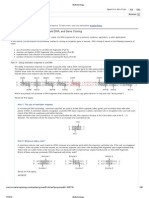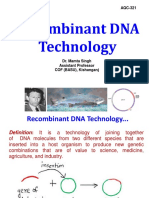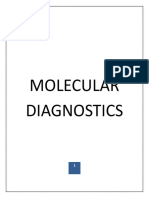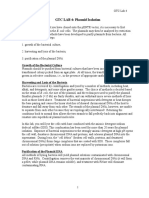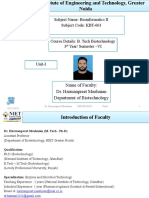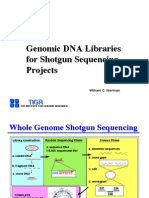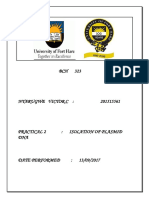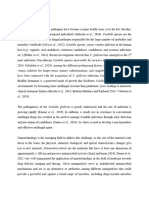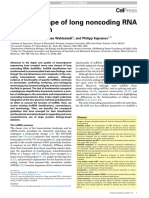100%(1)100% found this document useful (1 vote)
98 viewsDNA Microarray
DNA microarrays allow researchers to analyze gene expression levels across thousands of genes simultaneously. A microarray contains DNA probes affixed to a solid surface that bind to complementary cDNA or cRNA from samples of interest. After fluorescent labeling and hybridization, microarrays are scanned to detect gene expression differences as light intensities, which can reveal important biological insights into processes like disease. Common applications include cancer research, drug development, and toxicology studies.
Uploaded by
Shivam GuptaCopyright
© © All Rights Reserved
Available Formats
Download as PPTX, PDF, TXT or read online on Scribd
100%(1)100% found this document useful (1 vote)
98 viewsDNA Microarray
DNA microarrays allow researchers to analyze gene expression levels across thousands of genes simultaneously. A microarray contains DNA probes affixed to a solid surface that bind to complementary cDNA or cRNA from samples of interest. After fluorescent labeling and hybridization, microarrays are scanned to detect gene expression differences as light intensities, which can reveal important biological insights into processes like disease. Common applications include cancer research, drug development, and toxicology studies.
Uploaded by
Shivam GuptaCopyright
© © All Rights Reserved
Available Formats
Download as PPTX, PDF, TXT or read online on Scribd
You are on page 1/ 34
DNA Microarray
SUBMITTED TO: Prof. Prince Sharma
SUBMITTED BY: Shivam Gupta
Introduction
• DNA Microarray analysis is one of the fastest-growing new
technologies in the field of genetic research.
• Using DNA Microarray, researcher can pinpoint cells in the
differences in gene expression between two different cell types
in a single experiment.
• A Microarray is made up of thousands of spots. Each spots
contains multiple copies of a unique DNA sequence which
corresponds to a single gene.
• The precise location and sequence of each spot is recorded in a
computer database.
• DNA microarray technology is a recently developed technology
used in
- Cancer research
- Pharmacological treatment of diseases such as oral lesions.
HISTORY
• Southern Blotting was developed in the year 1975.
• This technology evolved from southern blotting, In 1979, this
approach was adapted to create ordered arrays by Gergen et.
al. (Gergen et. Al, 1979)
• The concept of DNA microarrays was proposed in the mid
1980s by Augenlicht & his colleagues.
• Steve Fodor developed scanner for reading the output.
• “Quantitative monitoring of Gene Expression Pattern with a
complementary DNA microarray” reported by Patrick Brown,
Mark Schena and Colleague in Science 1995.
• Complete genome of all Saccharomyces cerevisiae ORFs on a
microarray published in 1997 by Lashkari et al.
Microarray or DNA chip
• DNA microarray - gene chip, DNA chip or biochip is a
collection of microscopic DNA spots covalently attached to the
solid surface that can be
- Glass slides
- Silicon chips
Types Of Microarray
• Spotted arrays on glass,
• In-situ synthesized arrays.
• Self assembled arrays
Spotted DNA Microarray
• Spotted DNA Microarray are produced by printing DNA
samples on treated microscopic slides.
• It is made by transferring or spotting DNA clones or PCR
products individually onto a solid support (made up of
nylon filter or polylysine of glass slide) where they are
immobilized.
• When one DNA spotting is done, the pin is washed &
loaded with fresh DNA to start the second cycle.
ADVANTAGES : DISADVANTAGES:
• Low cost • highly variable spot
• Flexible deposition
• usually have to make your
• Compare two samples by
own
labeling with two different
flurophores and analyzing
on the same array ( Cy5 red
and Cy3 green)
In-situ Synthesized array
• In 1991 Fodor et.al. published a method for light directed,
spatially addressable chemical synthesis which combined
photolabile protecting groups( prevent DNA deposition) with
photolithography to perform chemical synthesis on a solid
substrate.
• In 1994, Fodor et.al. at the recently formed company of
Affymetrix demonstrated the ability to use this technology to
generate DNA arrays consisting of 256 different octa -
nucleotides.
• By 1995-1996, Affymetrix arrays were being used to detect
mutations in the reverse transcriptase and protease genes of
the highly polymorphic HIV-1 genome and to measure
variation in the human mitochondrial genome.
Oligonucleotides Arrays
• In Oligonucleotides microarrays, the probes are short
sequences designed to match parts of the sequence of known
or predicted open reading frames.
• Sequences may be longer (60-mer probes such as the Agilent
Technologies) or shorter (25-mer probes produced by
Affymetrix) depending on the desired purpose, longer probes
are more specific to individuals targets genes, shorter probes
may be spotted in higher density.
• The hybridization patterns & signal intensities can be
interpreted in terms of gene identity and relative expression
levels by Affymetrix GeneChip Operating Software.
ADVANTAGES : DISADVANTAGES:
• Speed, specificity and • Expensive
reproducibility • Limited flexibility.
• more uniform DNA features • Short sequences used on an
• Dynamic range may be array have decreased
slightly better sensitivity.
• Can buy off the shelf
Self assembled arrays
• An alternative approach to the construction of arrays was
created by the group of David Walt at Tuff University.
• Their methods involved synthesizing DNA on small
polystryrene beads and depositing those beads on the end of
fibre optic array in which the ends of the fibre were etched to
provide a well that is slightly larger than one bead.
Companies Manufacturing Microarray
• Affymetrix
• Agilent Technologies
• Asper Biotechnology
• Arrayit corporation
• BioRobotics
• Illumina
• PerkinElmer
• StatArray
• Genisphere
REQUIREMENT
• There are certain requirements for designing a DNA
microarray system:
DNA chip
Target sample ( fluorescently labelled)
Enzymes
Fluorescent dyes
Probes
Scanner
PRINCIPLE
• The Main Principle behind microarray is HYBRIDISATION
between two DNA strands.
• Complementary nucleic acid sequences get pair via Hydrogen
Bonds.
• After washing off non-specific bonding sequences, only
strongly paired strands will remains Hybridized.
• Fluorescently labeled target sequences that binds to a probe
sequence generate a signal.
• The signal depends on.
1. The hybridization Conditions, ex. temperature
2. Washing after Hybridization
PROCEDURE
• Collecting Sample - Take healthy tissue
sample and Tumor tissue sample by
using scalpel and the sample is then
put in two different eppendorfs.
• Extracting RNA from Tissue Sample -
Extract RNA from both tissue samples
by dissolving them into mixture of
solvents like Guanidinium
isothiocyanate.
• Mix the tissue samples on the Vortex
where tissue is dissolved and RNA is
released.
• Then put eppendorfs in
microcentrifuge so that RNA is
separated from cell components .
• Take the upper phase liquid and put
into new clean eppendorfs.
• The sample contains several types of
RNA in it: rRNA, tRNA, and mRNA.
• Wash our RNA sample over columns filled with
small beads that will only binds to RNA strands
that have a poly-A tail. The other molecules will
wash away.
• Columns now contains strands of mRNA
attached to the poly-T beads by their poly-A
tails.
• Then use mRNA binding buffer to separate the
mRNA from the beads and take the solution in
new eppendorfs. Buffer disrupts the pH &
hybrid bonds.
Create labelled cDNA - make DNA
copy of mRNA . To make cDNA:
• Add labeling mix to the mRNA.
(Labeling mix contains oligo -T
primers, reverse transcriptase,
fluorescently dyed nucleotides)
• Add cy3- fluoresces green to
healthy cells & cy5-fluoresces
red to the cancerous cells.
• Reverse transcriptase has assembled the labeled nucleotides
into cDNA molecules, and the mRNA molecules has been
degraded.
• Hybridization - Apply both the samples on our microarray chip
through micropipette.
• Most of the cDNA molecules hybridize to their complementary
DNA strands on the microarray. The remaining DNA fragments
are washed away.
• Now wash off the extra cDNAs that didn’t bind to the slide,
by placing microarray slide into washing Solution
• Scanning microarray - Now place the microarray plate into
the Scanner.
• Scanner has a laser, a camera, a computer
Laser causes hybrid bonds to fluoresce.
Camera record the images produced when the laser scan the chip.
Computer allows us to immediately view our results & it also stores
our data.
RED Spot – indicates that that gene was strongly expressed in cancer
GREEN Spot – indicates that that gene was strongly repressed in cancer
cells
YELLOW Spot – that gene was neither strongly expressed nor strongly
repressed in cancer cells.
BLACK Spot - none of the patient’s cDNA has bonded to the DNA
Advantages
• Allows the study of multiple genes at once.
• Different parts of DNA can be used to study gene expression
• Not limited to human genetic material; Can be used for all
species.
• One experiment instead of many.
• Can display thousands of different genes
• Fast and easy to obtain result
• Relatively low cost
Disadvantages
• A DNA array can only detect sequences that the array was
designed to detect.
• The DNA chip do not have very long shelf life.
• The results take a lot of time to analyze as the amount of data
collected from each array will be huge.
• The results may be too complex to interpret and are not
always quantitative.
• High variance for low expressed genes
Applications
DNA Microarray are used in many areas as given below:
• Diagnostic and Genetic engineering
• Alternative Splicing Detection
• Discovery of Drugs
• Functional Genomics
• Gene Expression Profiling
• DNA Sequencing
• Toxicological Research
• Proteomics
REFERENCES
• https://www.ncbi.nlm.nih.gov/pmc/articles/PMC4011503/
• https://www.youtube.com/watch?v=VNsThMNjKhM
• https://www.ncbi.nlm.nih.gov/pmc/articles/PMC3467903/
• https://www.researchgate.net/figure/Roche-NimbleGen-
oligonucleotide-microarray-Maskless-array-synthesizer-
technology-is_fig4_26888549
• https://en.m.wikipedia.org/wiki/DNA_microarray
• https://www.sciencedirect.com/topics/biochemistry-genetics-
and-molecular-biology/oligonucleotide-microarrays
• https://www.highveld.com/molecular-biology/
oligonucleotide-microarrays.html
•
THANK YOU
You might also like
- DNA Sanger Sequencing Worksheet Exercise: TH TH0% (1)DNA Sanger Sequencing Worksheet Exercise: TH TH3 pages
- DNA Sequencing at 40 - Past Present and FutureNo ratings yetDNA Sequencing at 40 - Past Present and Future10 pages
- Introduction To Molecular Biology: Marla Grace Costes100% (2)Introduction To Molecular Biology: Marla Grace Costes58 pages
- Immunoblotting: D3 Analis Medis, Fakultas Vokasi, Universitas Airlangga Dwi Wahyu Indriati100% (1)Immunoblotting: D3 Analis Medis, Fakultas Vokasi, Universitas Airlangga Dwi Wahyu Indriati30 pages
- Wiley - Gene Cloning and DNA Analysis An Introduction, 7th Edition - 978-1-119-07256-0No ratings yetWiley - Gene Cloning and DNA Analysis An Introduction, 7th Edition - 978-1-119-07256-02 pages
- Quantification of Nucleic Acids: Spectrophotometric AnalysisNo ratings yetQuantification of Nucleic Acids: Spectrophotometric Analysis2 pages
- Experiment No. 15 Practical: Polymerase Chain ReactionNo ratings yetExperiment No. 15 Practical: Polymerase Chain Reaction8 pages
- Transgenic Animals: Extended Response Task 2 - Semester 4 2010No ratings yetTransgenic Animals: Extended Response Task 2 - Semester 4 201010 pages
- Gene Cloning & Cloning Vectors: DR Ravi Kant Agrawal, MVSC, PHDNo ratings yetGene Cloning & Cloning Vectors: DR Ravi Kant Agrawal, MVSC, PHD75 pages
- Analysis of Chimeric Proteins by Fluorescence Microscopy and Western BlottingNo ratings yetAnalysis of Chimeric Proteins by Fluorescence Microscopy and Western Blotting18 pages
- A Systematic Review On The Comparison of Molecular Gene Editing ToolsNo ratings yetA Systematic Review On The Comparison of Molecular Gene Editing Tools8 pages
- PCR Techniques and Their Clinical Applications, 2023No ratings yetPCR Techniques and Their Clinical Applications, 202320 pages
- COURSE WORK MOLECULAR BIOLOGY & GeneticsNo ratings yetCOURSE WORK MOLECULAR BIOLOGY & Genetics3 pages
- Dna Purification and Extraction Practical Report100% (1)Dna Purification and Extraction Practical Report8 pages
- Genomic DNA Libraries For Shotgun Sequencing ProjectsNo ratings yetGenomic DNA Libraries For Shotgun Sequencing Projects40 pages
- Post Translational Modification of Proteins100% (1)Post Translational Modification of Proteins37 pages
- Next Generation Sequencing - : An OverviewNo ratings yetNext Generation Sequencing - : An Overview46 pages
- CG000330 ChromiumNextGEMSingleCell5 v2 CellSurfaceProtein RevANo ratings yetCG000330 ChromiumNextGEMSingleCell5 v2 CellSurfaceProtein RevA82 pages
- Chapter 20: Gene Isolation and ManipulationNo ratings yetChapter 20: Gene Isolation and Manipulation40 pages
- Download full Molecular Biology of The Cell 5th edition Alberts Test Bank all chapters100% (12)Download full Molecular Biology of The Cell 5th edition Alberts Test Bank all chapters49 pages
- Cancer Letters: Ana Hern Andez Martínez, Rodrigo Madurga, Noemí García-Romero, Angel Ayuso-SacidoNo ratings yetCancer Letters: Ana Hern Andez Martínez, Rodrigo Madurga, Noemí García-Romero, Angel Ayuso-Sacido14 pages
- Download Complete A Primer of Genome Science 3rd Edition Greg Gibson PDF for All Chapters100% (5)Download Complete A Primer of Genome Science 3rd Edition Greg Gibson PDF for All Chapters81 pages
- PCR Cdna Sequencing SQK pcs111 PCS - 9143 - v111 - Revq - 01dec2021 MinionNo ratings yetPCR Cdna Sequencing SQK pcs111 PCS - 9143 - v111 - Revq - 01dec2021 Minion32 pages
- Instant Download PDF Biology The Core 2nd Edition Simon Solutions Manual Full Chapter100% (22)Instant Download PDF Biology The Core 2nd Edition Simon Solutions Manual Full Chapter48 pages
- Microarray Data Analysis: Stuart M. Brown NYU School of MedicineNo ratings yetMicroarray Data Analysis: Stuart M. Brown NYU School of Medicine73 pages
- Niu Et Al., 2019, Galectin-3 Oreochromis NiloticusNo ratings yetNiu Et Al., 2019, Galectin-3 Oreochromis Niloticus9 pages
- (Ebook) Principles of Gene Manipulation and Genomics by Primrose S.B., Twyman R.M. ISBN 9781405135443, 1405135441 - The ebook in PDF format is ready for download100% (2)(Ebook) Principles of Gene Manipulation and Genomics by Primrose S.B., Twyman R.M. ISBN 9781405135443, 1405135441 - The ebook in PDF format is ready for download61 pages
- Biotechnology AND It Application: By: Dr. Anand ManiNo ratings yetBiotechnology AND It Application: By: Dr. Anand Mani7 pages
- Chapter One 1.0 Background To The StudyNo ratings yetChapter One 1.0 Background To The Study55 pages
- Human Molecular Genetics: Fourth EditionNo ratings yetHuman Molecular Genetics: Fourth Edition67 pages
- 8 Compressed Notes Recombinant Technology SdsNo ratings yet8 Compressed Notes Recombinant Technology Sds7 pages
- A Field Guide to Whole-genome Sequencing, Assembly and AnnotationNo ratings yetA Field Guide to Whole-genome Sequencing, Assembly and Annotation17 pages
- Immediate download RNA Methodologies: A Laboratory Guide for Isolation and Characterization 6th Edition Robert E. Farrell Jr. ebooks 2024100% (3)Immediate download RNA Methodologies: A Laboratory Guide for Isolation and Characterization 6th Edition Robert E. Farrell Jr. ebooks 202440 pages
- Basic Methods in Molecular Biology: Manipulations With DnaNo ratings yetBasic Methods in Molecular Biology: Manipulations With Dna17 pages
- 2024_Subretinal Microglia Support DonorNo ratings yet2024_Subretinal Microglia Support Donor10 pages
- Introduction To Molecular Biology: Marla Grace CostesIntroduction To Molecular Biology: Marla Grace Costes
- Immunoblotting: D3 Analis Medis, Fakultas Vokasi, Universitas Airlangga Dwi Wahyu IndriatiImmunoblotting: D3 Analis Medis, Fakultas Vokasi, Universitas Airlangga Dwi Wahyu Indriati
- Wiley - Gene Cloning and DNA Analysis An Introduction, 7th Edition - 978-1-119-07256-0Wiley - Gene Cloning and DNA Analysis An Introduction, 7th Edition - 978-1-119-07256-0
- Quantification of Nucleic Acids: Spectrophotometric AnalysisQuantification of Nucleic Acids: Spectrophotometric Analysis
- Experiment No. 15 Practical: Polymerase Chain ReactionExperiment No. 15 Practical: Polymerase Chain Reaction
- Transgenic Animals: Extended Response Task 2 - Semester 4 2010Transgenic Animals: Extended Response Task 2 - Semester 4 2010
- Gene Cloning & Cloning Vectors: DR Ravi Kant Agrawal, MVSC, PHDGene Cloning & Cloning Vectors: DR Ravi Kant Agrawal, MVSC, PHD
- Analysis of Chimeric Proteins by Fluorescence Microscopy and Western BlottingAnalysis of Chimeric Proteins by Fluorescence Microscopy and Western Blotting
- A Systematic Review On The Comparison of Molecular Gene Editing ToolsA Systematic Review On The Comparison of Molecular Gene Editing Tools
- PCR Techniques and Their Clinical Applications, 2023PCR Techniques and Their Clinical Applications, 2023
- Genomic DNA Libraries For Shotgun Sequencing ProjectsGenomic DNA Libraries For Shotgun Sequencing Projects
- Evaluation of Cellular Processes by in vitro AssaysFrom EverandEvaluation of Cellular Processes by in vitro Assays
- CG000330 ChromiumNextGEMSingleCell5 v2 CellSurfaceProtein RevACG000330 ChromiumNextGEMSingleCell5 v2 CellSurfaceProtein RevA
- Download full Molecular Biology of The Cell 5th edition Alberts Test Bank all chaptersDownload full Molecular Biology of The Cell 5th edition Alberts Test Bank all chapters
- Cancer Letters: Ana Hern Andez Martínez, Rodrigo Madurga, Noemí García-Romero, Angel Ayuso-SacidoCancer Letters: Ana Hern Andez Martínez, Rodrigo Madurga, Noemí García-Romero, Angel Ayuso-Sacido
- Download Complete A Primer of Genome Science 3rd Edition Greg Gibson PDF for All ChaptersDownload Complete A Primer of Genome Science 3rd Edition Greg Gibson PDF for All Chapters
- PCR Cdna Sequencing SQK pcs111 PCS - 9143 - v111 - Revq - 01dec2021 MinionPCR Cdna Sequencing SQK pcs111 PCS - 9143 - v111 - Revq - 01dec2021 Minion
- Instant Download PDF Biology The Core 2nd Edition Simon Solutions Manual Full ChapterInstant Download PDF Biology The Core 2nd Edition Simon Solutions Manual Full Chapter
- Microarray Data Analysis: Stuart M. Brown NYU School of MedicineMicroarray Data Analysis: Stuart M. Brown NYU School of Medicine
- Niu Et Al., 2019, Galectin-3 Oreochromis NiloticusNiu Et Al., 2019, Galectin-3 Oreochromis Niloticus
- (Ebook) Principles of Gene Manipulation and Genomics by Primrose S.B., Twyman R.M. ISBN 9781405135443, 1405135441 - The ebook in PDF format is ready for download(Ebook) Principles of Gene Manipulation and Genomics by Primrose S.B., Twyman R.M. ISBN 9781405135443, 1405135441 - The ebook in PDF format is ready for download
- Biotechnology AND It Application: By: Dr. Anand ManiBiotechnology AND It Application: By: Dr. Anand Mani
- A Field Guide to Whole-genome Sequencing, Assembly and AnnotationA Field Guide to Whole-genome Sequencing, Assembly and Annotation
- Immediate download RNA Methodologies: A Laboratory Guide for Isolation and Characterization 6th Edition Robert E. Farrell Jr. ebooks 2024Immediate download RNA Methodologies: A Laboratory Guide for Isolation and Characterization 6th Edition Robert E. Farrell Jr. ebooks 2024
- Basic Methods in Molecular Biology: Manipulations With DnaBasic Methods in Molecular Biology: Manipulations With Dna



